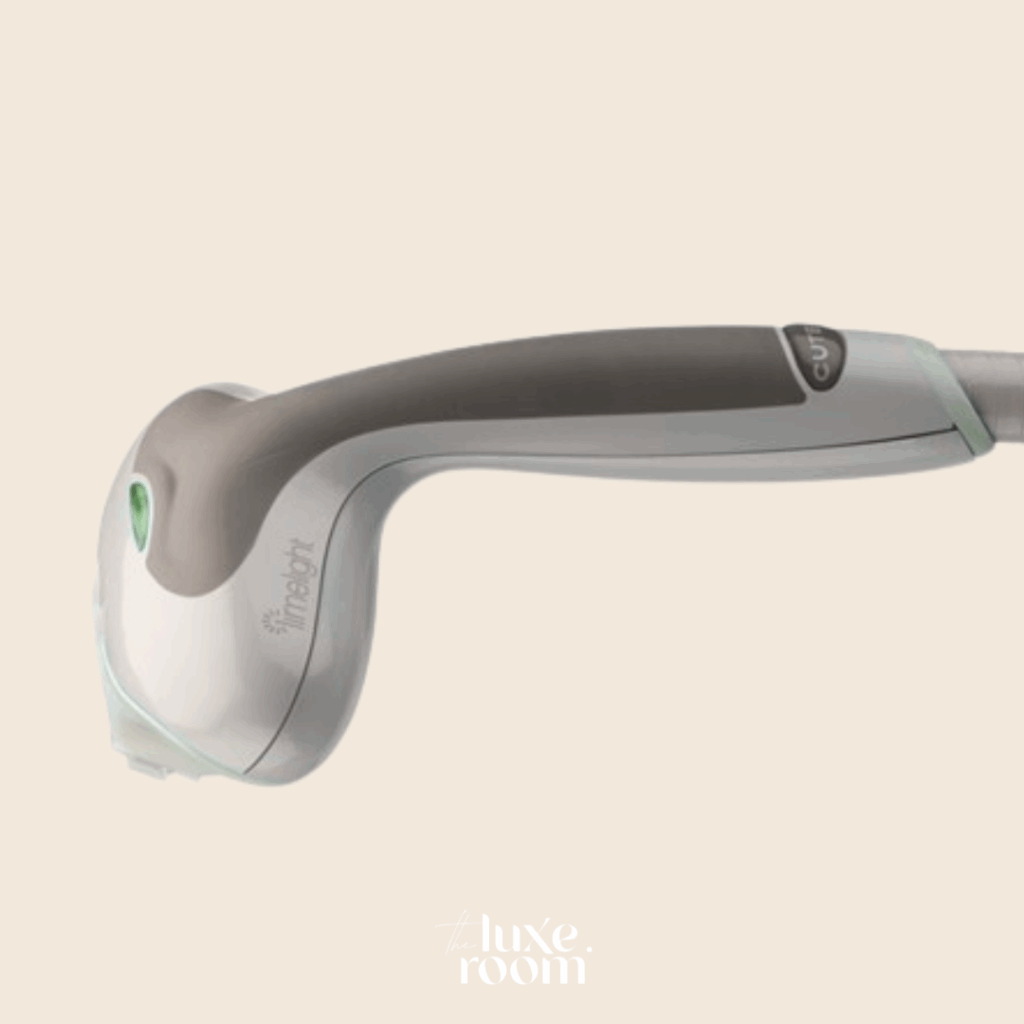IPL Photofacials: Fix Dark Spots, Redness & Dull Skin
When you have countless skin treatments to choose from, it can get overwhelming. So many of these devices seem to tackle similar issues, so how is IPL any different from all the lasers, microneedling, peels and facials out there?
IPL (Intense Pulsed Light) Photofacial has a very specific strength: it targets pigment, redness and uneven tone without damaging the surface of your skin. At The Luxe Room, we use the Cutera Limelight, a medical-grade device that works especially well on surface-level imperfections.
It’s especially effective for people dealing with sun damage, rosacea, or stubborn spots that just won’t fade, no matter how many products you’ve tried. So if you’re curious how everything works and if IPL is right for you, this is where you get your questions answered.
What Is an IPL Photofacial, And What Does It Actually Do?
Many people refer to IPL as a “laser facial,” but it’s not technically a laser. IPL stands for Intense Pulsed Light. As the name suggests, the device uses powerful broad-spectrum light to target various skin issues.
Unlike lasers, which emit a single wavelength, IPL uses multiple wavelengths that penetrate the skin at different depths. This makes it especially effective for targeting brown spots, redness, broken capillaries and uneven skin tone.
Our preferred tool for IPL Photofacials is Cutera Limelight, a professional-grade device that delivers controlled pulses of light energy directly into problem areas. That energy is absorbed by pigment (melanin) and blood vessels (hemoglobin) in the skin, where it heats and breaks them down.
Once broken down, the pigmentation fades away, and multiple sessions will ensure clear, radiant skin with fewer signs of aging and sun damage.
But IPL does more than correct; it also stimulates your body’s natural collagen production, leading to firmer, smoother skin with continued treatments. In short, it improves both how your skin looks and how it behaves over time.

What Skin Concerns Can IPL Photofacial Help With?
You may be familiar with this scenario. You skipped sunscreen and now you’ve got a lingering sun spot. Or maybe your skin isn’t bouncing back from breakouts the way it used to, leaving behind dark marks that don’t seem to budge. As we age, our skin doesn’t heal like it used to, so we need all the help we can get.
Pigment and freckles need a different approach, and so do vascular irregularities like persistent redness, rosacea, and broken capillaries. That’s where IPL comes in. IPL works by targeting the specific chromophores—melanin and hemoglobin. These structures soak up more of the IPL wavelength than the surrounding skin cells, allowing the treatment to heat and break them down without harming nearby tissue.
One of the most common reasons people seek IPL is to fade sun damage and age spots, especially on the face and chest. It’s also highly effective for diffuse redness, flushing, and broken vessels around the nose and cheeks. Those with rosacea often see a visible improvement in flare-ups and overall redness.
IPL can also improve post-inflammatory hyperpigmentation from acne, erasing dark marks that have been lingering for months, even years.
Most patients treat the face, neck, chest, and hands, though the arms, shoulders and other body areas can respond beautifully too.
What Does an IPL Treatment Feel Like?
Okay, let’s be honest. IPL treatments aren’t exactly comfy, but they’re not unbearable either. Pain levels depend on your personal tolerance and the settings used, but most people describe each light pulse as a quick rubber band snap. The sensation only lasts a fraction of a second.
Treatments typically take around 20 minutes for the face, sometimes even less.
Your eyes will be covered with goggles during the session because the light from the IPL device is extremely bright.
We don’t usually use numbing cream—especially when treating redness or visible vessels—since it can constrict blood vessels and interfere with the effectiveness of the treatment. That said, if we’re targeting brown spots or pigmentation, we can discuss numbing options.
What Should I Expect After an IPL Photofacial?
We’re using intense light during your treatment, so if your face feels a bit warm or looks slightly red afterward, that’s completely normal. It might feel like a mild sunburn (tight and a little tender), but that usually fades within a few hours. Some people still feel a bit of heat or notice a pink glow the next day, especially if we covered a larger area or if your skin’s on the sensitive side.
It’s also normal for pigmented spots to look darker before they get better. That’s good news, it just means the treatment is working. Freckles and sun spots might take on a coffee-ground look at first. Don’t worry, it’s just the pigment lifting. These darker patches usually flake off gently over the next few days, and what’s left behind is fresher, clearer skin.
There’s rarely any peeling or blistering, and most people don’t need to take time off. You might notice slight swelling, especially around the eyes, but that settles down quickly. Most clients go about their day as usual, and makeup is totally fine by the next morning.
One thing you don’t want to skip: SPF. Your skin will be more sensitive to light, and if you’re not using sunscreen, you’re basically undoing the treatment.

How Many IPL Photofacial Sessions Will I Need?
Like most medspa treatments, IPL isn’t one-and-done. For maximum skin rejuvenating benefits, we recommend a series of 3–4 sessions, spaced 2–4 weeks apart. Results are cumulative, with each session clearing more pigment, calming more redness, and stimulating more collagen.
Most clients start noticing visible improvements after just one or two sessions, with clearer, brighter skin continuing to develop over the following weeks.
While IPL greatly diminishes pigment, dark spots can return if the root cause (sun exposure and aging) persists. Maintaining your results is as simple as scheduling a routine treatment every other month.
Who Is IPL Best For—And Who Should Skip It?
IPL works best for fair to medium skin tones (Fitzpatrick I–III) dealing with sun spots, freckles, redness, broken capillaries, post-acne pigmentation, and dullness. But IPL isn’t for everyone.
If you have a fresh tan or plan on tanning soon, IPL is off-limits. The extra melanin in your skin can absorb the light in unintended ways, increasing your risk of burns or post-treatment hyperpigmentation.
Melasma is also a tricky one to treat with IPL. While superficial pigment can be faded with IPL, melasma may respond better to laser, but it’s best to consult with your provider on this one.
IPL is also not suitable for darker skin tones (Fitzpatrick V–VI) unless treated with extreme caution and proper settings. Darker skin contains more melanin, which competes with the pigment we’re trying to target. This can lead to overheating the targeted area and getting unwanted effects like burns or discoloration.
Pregnant or breastfeeding? Wait it out. IPL hasn’t been studied in these groups, and we always err on the side of safety.
Using Accutane, or dealing with an active skin infection or cold sore? Your skin is already highly sensitive and your skin barrier compromised, so we’ll need to hold off until it heals.
Got tattoos in the treatment area? IPL can interact unpredictably with tattoo ink, potentially causing fading, blistering, or burns. We avoid direct passes over tattoos entirely.
Bottom line: during your consult at The Luxe Room, we’ll assess your skin tone, history, and goals to make sure IPL is a safe and effective option for you.
IPL vs. Laser vs. Microneedling: What You Actually Need to Know
These treatments get grouped together a lot, but they’re not interchangeable. Each one targets something different—and understanding that makes your decision easier.
IPL is best when your skin’s surface looks uneven because of pigment or redness. We use it to treat sun spots, broken capillaries, and rosacea. It doesn’t resurface the skin or affect texture, although it does stimulate collagen production and rejuvenates skin from within. If your skin feels fine but looks blotchy or dull, this is the one we reach for.
Laser is different. It’s stronger, more targeted, and reaches deeper. Some lasers resurface the skin entirely, removing layers and triggering a complete regeneration. Others work deeper in the dermis to treat pigment, blood vessels, or laxity. You’ll likely need more downtime, but if you’re dealing with lines and wrinkles, scars, or years of damage, laser usually gives you more impact.
Microneedling works by triggering your body’s natural repair response. It’s not light-based at all—just very controlled, shallow injury using tiny needles. This wakes up collagen, smooths out texture, softens scarring, and tightens pores. It’s a slower process, but the results are worth it, especially when done consistently.

At The Luxe Room, we’re not interested in throwing treatments at your skin. We look at what’s actually happening in your tissue, what your goals are, and how much downtime you’re realistically okay with—then we build a plan that makes sense. Sometimes that’s IPL. Sometimes it’s not.
Why Do We Use Cutera Limelight at the Luxe Room?
Not all IPL devices are created equal. We use Cutera Limelight because it offers more precision, better customization, and safer energy delivery than most standard systems.
It adjusts in real time based on skin tone and treatment area, so we can safely target pigment and redness, even in more delicate zones like the neck or around the nose. This device also treats subtle discoloration that other IPLs often miss, especially in lighter skin.
Not sure if IPL is the right move? Let’s find out—together. At The Luxe Room, every treatment starts with a thoughtful consult where we get to know your skin, your goals, and what will actually deliver results you’ll love.
Book your consultation today and let us design a custom plan that brings out your best skin yet.



